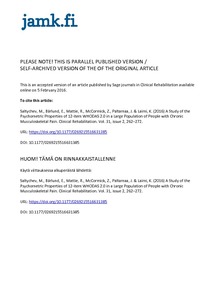A study of the psychometric properties of 12-item World Health Organization Disability Assessment Schedule 2.0 in a large population of people with chronic musculoskeletal pain
Saltychev, Mikhail; Bärlund, Esa; Mattie, Ryan; McCormick, Zachary; Paltamaa, Jaana; Laimi, Katri (2017)
Avaa tiedosto
Lataukset:
Saltychev, Mikhail
Bärlund, Esa
Mattie, Ryan
McCormick, Zachary
Paltamaa, Jaana
Laimi, Katri
Sage journals
2017
Julkaisun pysyvä osoite on
https://urn.fi/URN:NBN:fi:amk-2017061313391
https://urn.fi/URN:NBN:fi:amk-2017061313391
Tiivistelmä
Objective:
To assess the validity of the Finnish translation of the 12-item World Health Organization Disability Assessment Schedule (WHODAS 2.0).
Design:
Cross-sectional cohort survey study.
Setting:
Physical and Rehabilitation Medicine outpatient university clinic.
Subjects:
The 501 consecutive patients with chronic musculoskeletal pain.
Main measures:
Exploratory factor analysis and a graded response model using item response theory analysis were used to assess the constructs and discrimination ability of WHODAS 2.0.
Results:
The exploratory factor analysis revealed two retained factors with eigenvalues 5.15 and 1.04. Discrimination ability of all items was high or perfect, varying from 1.2 to 2.5. The difficulty levels of seven out of 12 items were shifted towards the elevated disability level. As a result, the entire test characteristic curve showed a shift towards higher levels of disability, placing it at the point of disability level of +1 (where 0 indicates the average level of disability within the sample).
Conclusions:
The present data indicate that the Finnish translation of the 12-item WHODAS 2.0 is a valid instrument for measuring restrictions of activity and participation among patients with chronic musculoskeletal pain.
To assess the validity of the Finnish translation of the 12-item World Health Organization Disability Assessment Schedule (WHODAS 2.0).
Design:
Cross-sectional cohort survey study.
Setting:
Physical and Rehabilitation Medicine outpatient university clinic.
Subjects:
The 501 consecutive patients with chronic musculoskeletal pain.
Main measures:
Exploratory factor analysis and a graded response model using item response theory analysis were used to assess the constructs and discrimination ability of WHODAS 2.0.
Results:
The exploratory factor analysis revealed two retained factors with eigenvalues 5.15 and 1.04. Discrimination ability of all items was high or perfect, varying from 1.2 to 2.5. The difficulty levels of seven out of 12 items were shifted towards the elevated disability level. As a result, the entire test characteristic curve showed a shift towards higher levels of disability, placing it at the point of disability level of +1 (where 0 indicates the average level of disability within the sample).
Conclusions:
The present data indicate that the Finnish translation of the 12-item WHODAS 2.0 is a valid instrument for measuring restrictions of activity and participation among patients with chronic musculoskeletal pain.
